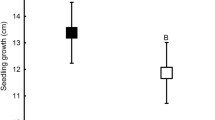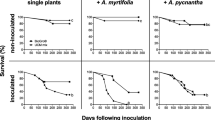Abstract
looseness-1In two observation fields, where six sites were artificially infested with Rhizoctonia solani AG 2-t, bare patches developed. These patches did not re-occur at the site of infestation in three successive years. In fields with and without artificial infestation, natural infection of tulip bulbs by Rhizoctonia spp. occurred. The spatial distribution of infected tulip bulbs was visualised in maps after kriging. The influence of sampling intensity was evaluated by stepwise reduction obtained in the observed data set of the first year. Omnidirectional semivariogram characteristics did not change when sampling intensity was reduced down to 10%. The average maximum prediction error was minimised at sampling intensities varying from 7% to 25%. Naturally occurring bare patches slowly vanished during successive cropping of flower bulbs and did not re-appear in the fourth growing season. A high frequency of isolation of R. solani AG 2-t in one field (Lisse-2) in the fourth consecutive crop did not result in bare patches in that year. It is hypothesised that a reduction in aggressiveness may account for this observation. In contrast, bulb rot due to Rhizoctonia spp. increased during the observation period. R. solani AG 5 isolates were seldom isolated before the bulbs flowered, but were the dominant isolate from bulbs at harvest. In a growth chamber experiment, it was demonstrated that AG 5 did not account for replacement of AG 2-t. However, it was demonstrated that competition may partially explain replacement of AG 2-t isolates during the growing season. At 18 °C, but not at 9 °C, an AG 4 isolate prevented AG 2-t colonising and infecting iris bulbs when both isolates were introduced together to soil. Rhizoctonia populations develop in relation to soil temperature and plant development. It is hypothesised that a ‘temporal niche differentiation’ may be one of the mechanisms affecting the dynamics of rhizoctonia bare patch of tulips.
Similar content being viewed by others
References
Anderson NA (1982) The genetics and pathology of Rhizoctonia solani. Annual Review of Phytopathology 20: 329-347
Boerema GH (1963) De veroorzaker van de ‘kwade-grondziekte’ bij bloembolgewassen: Rhizoctonia tuliparum Whetzel and Arthur. Verslagen en Mededelingen van de Plantenziektenkundige Dienst No. 141: 179-182
Bos L and Parlevliet JE (1995) Concepts and terminology on plant/pest relationships: towards consensus in plant pathology and crop protection. Annual review of Phytopathology 33: 69-102
Burgess TM, Webster R and McBratney AB (1981) Optimal interpolation and isarithmic mapping of soil properties. IV. Sampling strategy. Journal of Soil Science 32: 643-659
Burrough PA (1987) Spatial aspects of ecological data. In: Jongman RHG, Ter Braak CJF and Van Tongeren OFR (eds) Data Analysis in Community and Landscape Ecology (pp 213-251) PUDOC, Wageningen
Campbell CL and Madden LV (1990) Introduction to Plant Disease Epidemiology. Wiley, New York
Cardoso JE and Echandi E (1987) Nature of protection of bean seedlings from Rhizoctonia root rot by a binucleate Rhizoctonia-like fungus. Phytopathology 77: 1548-1551
Carling DE (1996) Grouping in Rhizoctonia solani by hyphal anastomosis interactions. In: Sneh B, Jabaji-Hare S, Neate SM and Dijst G (eds) Rhizoctonia Species: Taxonomy, Molecular Biology, Ecology, Pathology and Disease Control (pp 35-48) Kluwer, Dordrecht
Corel DRAW 6.0 (1995) Corel Corporation, Ottawa
Corsten LCA and Stein A (1994) Nested sampling for estimating spatial semivariograms compared to other designs. Applied Stochastic Models and Data Analysis 10: 103-122
Daniels J (1963) Saprophytic and parasitic activities of some isolates of Corticium solani. Transactions of the British Mycological Society 46: 485-501
De Hertogh AA, Aung LH and Benschop M (1983) The tulip: botany, usage, growth, and development. In: Janick J (ed) Horticultural Reviews, Vol. 5 (pp 45-125) AVI, Westport, Connecticut
Dijst G and Schneider JHM (1996) Flower bulb diseases incited by Rhizoctonia species. In: Sneh B, Jabaji-Hare S, Neate SM and Dijst G (eds) Rhizoctonia Species: Taxonomy, Molecular Biology, Ecology, Pathology and Disease Control (pp 279-288) Kluwer, Dordrecht
Doornik AW(1981) Temperature dependence of the pathogenicity of several isolates of Rhizoctonia solani in some bulb crops as an intrinsic property of the isolate. Netherlands Journal of Plant Pathology 87: 139-147
Flentje NT and Saksena H (1957) Studies on Pellicularia filamentosa (Pat.) Rogers. II. Occurrence and distribution of pathogenic strains. Transactions of the British Mycological Society. 40: 95-108
Genstat 5 Committee (1995) Genstat 5 Release 3.2 Reference Manual. Clarendon, Oxford
Harris JR and Moen R (1985) Replacement of Rhizoctonia solani on wheat seedlings by a succession of root rot-fungi. Transactions of the British Mycological Society 84: 11-20
Hyakumachi M (1983) Decline phenomenon of sugar beet root rot. Shokubutsu Boeki (Plant Protection) 37: 532-537
Hyakumachi M, Kanzawa K and Ui T (1990) Rhizoctonia root rot decline in sugarbeet monoculture. In: Cook RJ, Henis Y, Ko WH, Rovira AD, Schippers B and Scott PR (eds) Biological Control of Soil-borne Plant Pathogens (pp 227-247) CAB International, Wallingford
Jager G and Velvis H (1995) Dynamics of Rhizoctonia solani (black scurf) in successive potato crops. European Journal of Plant Pathology 101: 467-478
Journel AG and Huijbregts CJ (1978) Mining Geostatistics. Academic Press London
Koster AThJ and Van de Meer LJ (1990) Control of Rhizoctonia solani in the field with a low dosage of Tolclofos-Methyl or Flutolanil. Acta Horticultura 266: 419-424
Lannou C and Savary S (1991) The spatial structure of spontaneous epidemics of different diseases in a groundnut plot. Netherlands Journal of Plant Pathology 97: 355-368
Le Nard M and De Hertogh AA (1993) Tulipa. In: De Hertogh A and Le Nard M (eds) The Physiology of Flower Bulbs (pp 617-682) Elsevier, Amsterdam
Lucas P, Smiley RW and Collins HP (1993) Decline of Rhizoctonia root rot on wheat in soil infested with Rhizoctonia solani AG 8. Phytopathology 83: 260-265
MacNish GC (1985) Mapping Rhizoctonia patch in consecutive cereal crops in Western Australia. Plant Pathology 34: 164-174
MacNish GC (1988) Changes in take-all (Gaeumannomycis graminis var tritici), Rhizoctonia root rot (Rhizoctonia solani) and soil pH in continuous wheat with annual applications of nitrogenous fertiliser in Western Australia. Australian Journal of Experimental Agriculture 28: 333-341
MacNish GC (1996) Patch dynamics and bare patch. In: Sneh B, Jabaji-Hare S, Neate SM and Dijst G (eds) Rhizoctonia Species: Taxonomy, Molecular Biology, Ecology, Pathology and Disease Control (pp 217-226) Kluwer, Dordrecht
MacNish GC and Neate SM (1996) Rhizoctonia bare patch of cereals: an Australian perspective. Plant Disease 80: 965-971
Martin SB (1987) Rapid tentative identification of Rhizoctonia spp. associated with diseased turfgrasses. Plant Disease 71: 47-49
Matheron G (1963) Principles of geostatistics. Economic Geology 58: 1246-1266
Neate SM and Schneider JHM (1996) Sampling and quantification of Rhizoctonia solani in soil. In: Sneh B, Jabaji-Hare S, Neate S and Dijst G (eds) Rhizoctonia Species: Taxonomy, Molecular Biology, Ecology, Pathology and Disease Control (pp 185-195) Kluwer, Dordrecht
Schneider JHM (1998) Rhizoctonia disease of tulip: characterization and dynamics of the pathogens. Ph.D thesis, Wageningen Agricultural University
Schneider JHM, Salazar O, Rubio V and Keijer J (1997a) Identification of Rhizoctonia solani isolates associated with field-grown tulips using ITS rDNA polymorphism and pectic zymograms. European Journal of Plant Pathology 103: 607-622
Schneider JHM, Schilder MT and Dijst G (1997b) Characterization of Rhizoctonia solani AG 2 isolates causing bare patch in field grown tulips in the Netherlands. European Journal of Plant Pathology 103: 265-279
Schneider JHM, Van den Boogert PHJF and Zadoks JC (1999) Exploring differential interactions between Rhizoctonia solani AG 2-t isolates and tulip cultivars. Plant Disease 83: 474-481
Sneh B, Burpee L and Ogoshi A (1991) Identification of Rhizoctonia species. The American Phytopathological Society, St Paul, Minnesota
Sneh B, Zeidan M, Ichielevich-Auster M and Barash I (1986) Increased growth responses induced by a non pathogenic Rhizoctonia solani. Canadian Journal of Botany 64: 2372-2378
Sonderman CH and MacLean NA (1949) Rhizoctonia neck and bulb rot of iris in the pacific northwest. Phytopathology 39: 174-175
Stein A, Kocks CG, Zadoks JC, Frinking HD, Ruissen MA and Myers DE (1994) A geostatistical analysis of the spatiotemporal development of downy mildewepidemics in cabbage. Phytopathology 84: 1227-1239
Van den Boogert PHJF, Jager G and Velvis H 1990 (1990) Verticillium biguttatum, an important mycoparasite for the control of Rhizoctonia solani in potato. In: Hornby D (ed) Biological Control of Soil-Borne Plant Pathogens (pp 77-91) CAB International, Wallingford
Webster R (1985) Quantitative spatial analysis of soil in the field. In: Stewart BA (ed) Advances in Soil Science, Vol 3 (pp 1-70) Springer, New York
Webster R and Burgess TM (1984) Sampling and bulking strategies for estimating soil properties in small regions. Journal of Soil Science 35: 127-140
Wiseman BM, Neate SM, Ophel Keller K and Smith SE (1996) Suppression of Rhizoctonia solani anastomosis group 8 in Australia and its biological nature. Soil Biology and Biochemistry 28: 727-732
Author information
Authors and Affiliations
Rights and permissions
About this article
Cite this article
Schneider, J., Kocks, C. & Schilder, M. Possible Mechanisms Influencing the Dynamics of Rhizoctonia Disease of Tulips. European Journal of Plant Pathology 107, 723–738 (2001). https://doi.org/10.1023/A:1011976003979
Issue Date:
DOI: https://doi.org/10.1023/A:1011976003979




